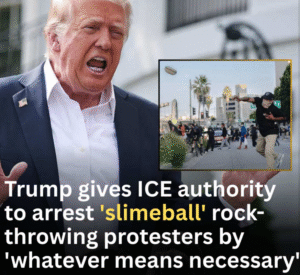Former President Donald Trump has authorized Immigration and Customs Enforcement (ICE) agents to take aggressive action against protesters who throw rocks, referring to them as “slimeballs” and instructing that they be arrested “by whatever means necessary.” This directive marks an escalation in the federal government’s approach to managing civil unrest and has sparked significant controversy and debate across political and social spheres.
Trump’s statement came amid ongoing protests in various parts of the country, where demonstrators have clashed with law enforcement over a range of issues. Some protests have been marked by acts of vandalism and violence, including the throwing of rocks and other projectiles at officers. The former president’s comments were seen as a signal to federal agencies, particularly ICE, to adopt a more forceful stance in dealing with such protesters.
By giving ICE this authority, Trump effectively expanded the role of an agency traditionally focused on immigration enforcement into the realm of crowd control and public order management. ICE officers, who usually deal with immigration violations and deportations, are now being tasked with arresting individuals involved in protest-related violence. The phrase “by whatever means necessary” was interpreted by many as a green light for the use of aggressive and potentially excessive force.
Critics of the move argue that this blurs the lines between immigration enforcement and law enforcement duties, potentially leading to abuses of power and violations of civil liberties. Civil rights groups and activists have condemned the directive, warning that it risks escalating tensions and undermining constitutional rights to free speech and peaceful assembly. They fear that such orders could result in arbitrary arrests and the targeting of vulnerable communities, especially immigrants and minorities.
Supporters, on the other hand, argue that the move is necessary to restore law and order amid growing unrest. They point to the dangers posed by violent protesters and assert that law enforcement agencies need broad authority to protect public safety and prevent further damage. Some conservatives have praised Trump’s tough rhetoric and strong stance against what they describe as lawlessness.
The legal implications of this directive have also been questioned. Experts note that ICE’s jurisdiction is limited by federal laws and regulations, and its involvement in arresting protesters could raise constitutional challenges. Questions have arisen regarding the appropriate use of federal resources, the scope of ICE’s authority, and the potential conflicts with local law enforcement agencies, who traditionally handle protests and civil disturbances.
The directive has also drawn attention to the broader federal response to protests and civil unrest, which has included the deployment of federal agents to cities experiencing demonstrations. In some cases, federal officers have been criticized for using aggressive tactics, including detentions without clear cause, use of tear gas, and physical confrontations. These tactics have fueled debates about militarization of law enforcement and the balance between security and civil rights.
In addition, Trump’s language, labeling protesters as “slimeballs,” has been condemned as inflammatory and dehumanizing. Such rhetoric is seen by many as contributing to increased polarization and hostility, undermining efforts to engage in constructive dialogue and address the underlying issues prompting protests.
The directive’s impact on ICE officers themselves has been mixed. Some agents reportedly feel conflicted about being assigned to roles outside their usual responsibilities, concerned about the legal and ethical ramifications. Others support the expanded mandate as necessary in the current climate of unrest.
Local governments and police departments have responded in varied ways. Some have welcomed federal assistance, citing stretched resources and the need for backup. Others have criticized federal intervention as heavy-handed and counterproductive, emphasizing the importance of community-based approaches to managing protests.
The announcement has also prompted discussions about the future role of ICE and the scope of federal law enforcement powers. Advocates for reform argue that the agency should focus solely on immigration enforcement and avoid involvement in domestic policing issues. The directive has intensified calls for oversight and clearer boundaries regarding the use of federal agencies in managing civil unrest.
As protests continue in various regions, the situation remains tense, with communities and officials grappling with how to balance safety, order, and rights. The directive from Trump represents a significant moment in the ongoing debate over the federal government’s approach to dissent and the use of force in public demonstrations.
In summary, former President Trump’s order granting ICE authority to arrest rock-throwing protesters “by whatever means necessary” has escalated federal involvement in managing protests and ignited controversy over civil liberties, law enforcement boundaries, and the politicization of public safety. The move has prompted widespread debate about the appropriate use of federal power and the impact of aggressive rhetoric on an already divided nation.


